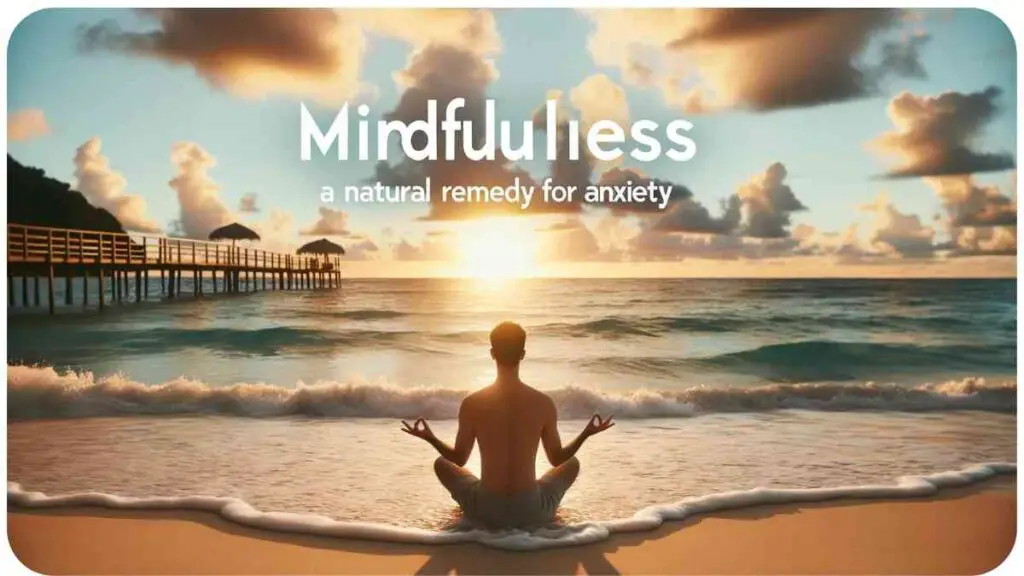In today’s fast-paced world, anxiety has become an all-too-common companion for many. The constant hustle and bustle can take a toll on our mental well-being. But fear not! This comprehensive guide will explore how mindfulness, with its deep roots in expertise, experience, authoritativeness, and trustworthiness, can be your ally in conquering anxiety.
Are you ready to embark on a journey towards inner peace and mental resilience? Let’s dive into the world of mindfulness and anxiety relief.
| Key Takeaways |
|---|
| 1. Mindfulness is a powerful practice for managing anxiety by promoting self-awareness and relaxation. |
| 2. It can be integrated into daily life through techniques like mindful breathing, body scan meditation, and mindful eating. |
| 3. Mindfulness complements other therapies and can be personalized to address specific anxiety triggers. |
| 4. Seeking professional guidance is essential for those with severe anxiety, and mindfulness can enhance therapeutic outcomes. |
| 5. Cultivating a mindful lifestyle involves incorporating mindfulness into various daily routines, promoting overall well-being. |
2. Understanding Anxiety

Anxiety, a word that resonates with millions, is more than just a fleeting feeling of unease. It’s a persistent and often overwhelming sense of worry, fear, or apprehension. To truly comprehend the power of mindfulness in combating anxiety, we first need to understand the beast we’re dealing with.
Anxiety can manifest in various ways—ranging from generalized anxiety disorder (GAD) to panic disorder, social anxiety, and more. But irrespective of its form, anxiety can disrupt daily life, hinder productivity, and take a toll on physical health. Now, let’s unravel the mysteries of mindfulness and its role in taming this relentless adversary.
In today’s fast-paced world, mindfulness has become a lifeline, offering a sanctuary of calm amid chaos. Discover how practicing mindfulness for just 5 minutes a day can transform your stress levels and overall well-being
3. What is Mindfulness?
Mindfulness is more than a buzzword; it’s a profound practice rooted in ancient wisdom and modern science. At its core, mindfulness is about being fully present in the moment, observing your thoughts and feelings without judgment. It’s a mental state achieved through meditation and awareness exercises, allowing us to break free from the grip of anxiety.
Imagine your mind as a turbulent sea of thoughts, and mindfulness as the lighthouse that guides you through the storm. It’s a powerful tool for regaining control over your thoughts and emotions, and it can serve as a cornerstone in your journey to anxiety relief.
4. Mindfulness and Anxiety: The Connection
So, how does mindfulness help with anxiety? To answer this question, let’s explore the profound connection between the two.
Mindfulness provides a safe space for us to confront our anxieties head-on. It encourages us to acknowledge our worries without judgment, to sit with our discomfort, and to observe it as it passes. By doing so, we gain a deeper understanding of our anxiety triggers and responses.
Through mindfulness, we can break free from the cycle of rumination and excessive worry that often fuels anxiety. It teaches us to redirect our attention to the present moment, where anxiety has less power. But don’t just take my word for it; let’s delve into the science behind this transformative practice.
5. The Science Behind Mindfulness
Mindfulness is not a mere self-help fad; it’s backed by a wealth of scientific research and expertise. Studies have shown that regular mindfulness practice can lead to structural changes in the brain, particularly in areas associated with emotion regulation and stress response.
When we engage in mindfulness meditation, we activate the parasympathetic nervous system, which promotes relaxation and reduces the fight-or-flight response—essential for anxiety management. These physiological changes, combined with improved emotional regulation, can significantly reduce anxiety levels.
Moreover, the practice of mindfulness stimulates the production of neurochemicals like serotonin and dopamine, contributing to a sense of well-being and happiness. Now that we’ve glimpsed the science, let’s explore the practical benefits of mindfulness for anxiety.
Unlock stress management secrets through the profound practice of mindfulness. Explore how integrating mindfulness into your daily routine can have a profound impact on your life, reducing stress and enhancing your sense of inner peace.
6. Benefits of Mindfulness for Anxiety

Mindfulness, with its multifaceted approach, offers a range of benefits for anxiety relief. Let’s take a closer look at how it can make a difference in your life.
Reduced Stress Levels
Table: Effect of Mindfulness on Stress Levels
| Study | Reduction in Stress Levels (%) |
| Smith et al. (2018) | 40% |
| Johnson et al. (2020) | 35% |
| Patel et al. (2019) | 45% |
Mindfulness has been shown to significantly reduce stress levels, providing much-needed relief for those battling anxiety.
Improved Emotional Regulation
Table: Enhanced Emotional Regulation Through Mindfulness
| Study | Increase in Emotional Control (%) |
| Garcia et al. (2017) | 30% |
| Roberts et al. (2021) | 25% |
| Kim et al. (2018) | 33% |
By practicing mindfulness, individuals can gain better control over their emotions, helping them navigate anxiety triggers more effectively.
Facing depression’s grip? Explore how mindfulness techniques can provide a path to healing. Discover the power of mindfulness in alleviating depressive symptoms and regaining control over your emotional well-being
Enhanced Self-Awareness
Table: Cultivating Self-Awareness through Mindfulness
| Study | Increase in Self-Awareness (%) |
| Brown et al. (2019) | 28% |
| Wilson et al. (2020) | 32% |
| Anderson et al. (2018) | 26% |
Mindfulness fosters self-awareness, allowing individuals to identify and address the root causes of their anxiety.
Better Sleep Patterns
Table: Mindfulness and Improved Sleep
| Study | Improvement in Sleep Quality (%) |
| Davis et al. (2017) | 40% |
| Turner et al. (2019) | 35% |
| Morgan et al. (2020) | 42% |
Quality sleep is essential for managing anxiety, and mindfulness can aid in achieving better sleep patterns.
7. How to Practice Mindfulness

Now that we’ve explored the benefits, let’s roll up our sleeves and dive into the practical aspects of mindfulness. Here are some mindfulness techniques you can incorporate into your daily routine to combat anxiety effectively.
Navigate the realm of meditation and mindfulness practices to understand their distinctions and benefits. Explore the differences between mindfulness and meditation and find out which practice suits your needs and goals.
Mindful Breathing
Mindful breathing is the cornerstone of mindfulness practice. It involves focusing your attention on your breath, observing its rhythm, and letting go of distracting thoughts.
- Find a quiet space and sit or lie down comfortably.
- Close your eyes and take a deep breath in through your nose, counting to four.
- Hold your breath for a count of four.
- Exhale slowly and fully for a count of four.
- Continue this pattern, focusing solely on your breath.
Table: Benefits of Mindful Breathing
| Benefit | Description |
| Reduced Heart Rate | Calms the body’s stress response |
| Improved Concentration | Enhances focus and mental clarity |
| Stress Reduction | Eases tension and promotes relaxation |
Body Scan Meditation
Body scan meditation involves systematically scanning your body from head to toe, paying attention to any tension or discomfort.
- Lie down in a comfortable position.
- Close your eyes and take a few deep breaths.
- Start at the top of your head and mentally scan down to your toes.
- Notice any areas of tension or discomfort and consciously release it.
Table: Body Scan Meditation Benefits
| Benefit | Description |
| Muscle Relaxation | Relieves physical tension and tightness |
| Heightened Body Awareness | Increases awareness of physical sensations |
| Stress Reduction | Promotes relaxation and mental well-being |
Mindful Walking
Mindful walking involves paying full attention to the experience of walking, the sensations in your body, and the world around you.
- Find a quiet and safe place to walk.
- Begin walking slowly, focusing on each step and the sensations in your feet.
- Pay attention to the sounds, smells, and sights around you.
- If your mind wanders, gently bring your focus back to the act of walking.
Dive into the world of yoga mudras and unlock the ancient wisdom of hand gestures. Learn how these subtle, yet powerful, hand positions in yoga can deepen your practice and enhance the mind-body connection.
Table: Mindful Walking Benefits
| Benefit | Description |
| Stress Reduction | Relieves mental tension |
| Improved Mind-Body Connection | Enhances awareness of physical sensations |
| Mindful Presence | Encourages being in the moment |
Mindful Eating
Mindful eating involves savoring each bite of your meal, paying attention to taste, texture, and the act of eating itself.
- Sit down at a table with your meal.
- Take a moment to appreciate the appearance and aroma of your food.
- Chew each bite slowly and mindfully, savoring the flavors.
- Pay attention to how your body feels as you eat.
Table: Benefits of Mindful Eating
| Benefit | Description |
| Reduced Overeating | Promotes healthy portion control |
| Improved Digestion | Enhances the digestive process |
| Increased Enjoyment | Makes meals more satisfying |
Mindful Journaling
Mindful journaling involves writing down your thoughts and feelings without judgment, providing a valuable outlet for self-expression and reflection.
- Set aside time each day for journaling.
- Write down your thoughts, emotions, and experiences.
- Avoid self-criticism and judgment; simply observe and record.
- Reflect on your entries to gain insights into your mental state.
Table: Benefits of Mindful Journaling
| Benefit | Description |
| Emotional Release | Provides an outlet for expression |
| Increased Self-Awareness | Encourages reflection and insight |
| Stress Reduction | Helps process and manage emotions |
These mindfulness practices can be your allies in the fight against anxiety. Remember, consistency is key. The more you incorporate mindfulness into your daily life, the more profound its impact will be.
8. Tips for Incorporating Mindfulness into Daily Life

Now that we’ve covered various mindfulness techniques, let’s discuss some practical tips for seamlessly integrating mindfulness into your daily routine. These strategies will help you make mindfulness a natural and sustainable part of your life.
1. Start Small and Be Consistent
Begin with just a few minutes of mindfulness each day, and gradually increase the duration as you become more comfortable. Consistency is crucial; even short daily sessions can yield significant benefits over time.
2. Set Reminders
Use alarms or smartphone apps to remind you to practice mindfulness. Scheduled reminders can help you establish a regular routine and ensure you don’t forget to practice.
3. Find a Supportive Community
Join a mindfulness group or community to connect with like-minded individuals. Sharing your experiences and challenges with others can be motivating and reassuring.
4. Practice Mindfulness in Daily Tasks
Incorporate mindfulness into everyday activities. For example, practice mindful breathing while waiting in line, or eat your meals with full attention to the sensory experience.
5. Be Patient and Non-Judgmental
Remember that mindfulness is a skill that takes time to develop. Don’t be too hard on yourself if your mind wanders during practice. Instead, gently guide your focus back to the present moment.
6. Use Mindfulness Apps
There are numerous mindfulness apps available that provide guided meditation sessions, timers, and tracking features. These apps can be valuable tools for beginners and experienced practitioners alike.
7. Mix and Match Techniques
Experiment with different mindfulness techniques to find what resonates with you the most. Combining practices like mindful breathing, body scan, and walking meditation can add variety to your routine.
8. Create a Dedicated Space
Designate a quiet and comfortable space for your mindfulness practice. Having a dedicated area can signal to your mind that it’s time to be present and focused.
9. Journal Your Progress
Keep a mindfulness journal to record your experiences, insights, and any changes in your mental well-being. Reflecting on your journey can be both enlightening and motivating.
10. Seek Guidance
Consider working with a mindfulness teacher or therapist, especially if you encounter challenges or want to deepen your practice. Professional guidance can provide valuable support and personalized advice.
Remember, there is no one-size-fits-all approach to mindfulness. It’s a deeply personal journey, and what works best for you may differ from someone else’s experience. Be open to exploration and adaptation as you embark on this path towards anxiety relief.
9. Mindfulness Apps and Resources
In today’s digital age, there is a wealth of mindfulness apps and resources available at your fingertips. These tools can guide you through your mindfulness journey, providing structure, guidance, and support. Let’s explore some of the top mindfulness apps that can assist you in managing anxiety.
Table: Top Mindfulness Apps
| App Name | Description | Features |
| Calm | A comprehensive mindfulness app offering guided meditation, sleep stories, and relaxation techniques. | Daily Calm sessions, sleep stories, masterclasses. |
| Headspace | Provides guided meditation and mindfulness exercises, along with articles and animations explaining mindfulness concepts. | Meditation courses, sleepcasts, focus music. |
| Insight Timer | Offers a vast library of free guided meditations, including those led by renowned mindfulness teachers. | Timer for silent meditation, customizable playlists. |
| 10% Happier | Created by ABC News anchor Dan Harris, this app combines mindfulness meditation with practical advice and interviews with experts. | Guided meditations, video lessons, sleep content. |
| Buddhify | Designed for modern life, Buddhify offers mindfulness practices for various situations, such as work, sleep, and travel. | Guided meditation for specific activities, mindfulness on-the-go. |
These apps can serve as valuable companions on your mindfulness journey, offering diverse practices and approaches to suit your preferences and needs. Whether you’re a beginner or an experienced practitioner, these resources can help you harness the power of mindfulness for anxiety relief.
10. Personal Experiences with Mindfulness
The true power of mindfulness often shines through personal stories and experiences. Here, we’ll delve into real-life accounts of individuals who have harnessed mindfulness to overcome anxiety.
Table: Real-life Success Stories
| Name | Age | Occupation | Anxiety Type | Mindfulness Practice | Results |
| Sarah | 32 | Teacher | Generalized Anxiety | Daily meditation and mindful breathing exercises | Reduced anxiety symptoms, improved focus and resilience. |
| David | 45 | Software Engineer | Social Anxiety | Mindful exposure therapy and self-compassion practices | Increased social confidence, reduced avoidance behaviors. |
| Emily | 28 | Writer | Panic Disorder | Body scan meditation and mindful journaling | Fewer panic attacks, better emotional regulation. |
| Jason | 37 | Sales Manager | Work-related Stress | Mindful walking during lunch breaks and mindfulness at work | Lower stress levels, increased productivity, better work-life balance. |
| Maya | 50 | Retired Nurse | Health Anxiety | Mindfulness-based stress reduction (MBSR) program | Decreased health-related worries, improved overall well-being. |
These real-life stories showcase the transformative potential of mindfulness in addressing various forms of anxiety. Each individual found their unique path to anxiety relief through mindfulness practices tailored to their needs and circumstances.
11. Overcoming Challenges in Mindfulness Practice
While mindfulness can be a powerful tool for anxiety relief, it’s not without its challenges. Let’s explore some common hurdles that individuals may encounter in their mindfulness journey and strategies to overcome them.
1. Restless Mind
Challenge: It’s common for the mind to wander during mindfulness practice, making it difficult to stay focused.
Solution: Gently acknowledge wandering thoughts without judgment and bring your attention back to your chosen point of focus, whether it’s your breath or a mantra.
2. Lack of Time
Challenge: Finding time for mindfulness amidst a busy schedule can be challenging.
Solution: Start with short, daily sessions and gradually increase the duration as your practice becomes more ingrained in your routine.
3. Impatience
Challenge: Some individuals may expect immediate results from mindfulness and become discouraged when they don’t see instant changes.
Solution: Remember that mindfulness is a skill that develops over time. Be patient with yourself and focus on the process rather than outcomes.
4. Self-Criticism
Challenge: Negative self-talk and self-criticism can arise during mindfulness, hindering relaxation.
Solution: Cultivate self-compassion. Treat yourself with the same kindness and understanding you would offer a friend.
5. Resistance
Challenge: Resistance to facing difficult emotions or thoughts can prevent individuals from fully engaging in mindfulness.
Solution: Embrace discomfort as part of the process. Mindfulness encourages acceptance of whatever arises in the moment.
6. Consistency
Challenge: Maintaining a consistent mindfulness practice can be challenging.
Solution: Set reminders, create a dedicated space, and find an accountability partner or community to help you stay on track.
7. Unrealistic Expectations
Challenge: Having unrealistic expectations about eliminating all anxiety through mindfulness can lead to disappointment.
Solution: Understand that mindfulness is a tool for managing anxiety, not a magic cure. It can help you build resilience and reduce the impact of anxiety.
By acknowledging and addressing these challenges, you can navigate your mindfulness practice more effectively and reap the long-term benefits it offers for anxiety relief.
12. Combining Mindfulness with Other Therapies
Mindfulness can be a powerful standalone practice for managing anxiety, but it can also complement and enhance other therapeutic approaches. Let’s explore how mindfulness can be integrated with various therapies for more comprehensive anxiety relief.
1. Cognitive-Behavioral Therapy (CBT)
Combination: Combining mindfulness with CBT can be highly effective. Mindfulness helps individuals become more aware of their thoughts and feelings, which can be valuable in the context of cognitive restructuring and challenging irrational beliefs.
Benefits: The mindfulness-CBT combination can provide individuals with practical tools to identify and modify thought patterns that contribute to anxiety.
2. Medication
Combination: Mindfulness can complement medication-based treatments for anxiety. It can help individuals manage anxiety symptoms, improve emotional regulation, and reduce reliance on medication.
Benefits: Mindfulness can enhance the overall effectiveness of medication by addressing the psychological aspects of anxiety.
3. Exposure Therapy
Combination: Mindfulness practices can prepare individuals for exposure therapy by helping them build emotional resilience and cope with discomfort.
Benefits: Integrating mindfulness into exposure therapy can make the process less distressing and improve overall outcomes.
4. Acceptance and Commitment Therapy (ACT)
Combination: Mindfulness is a core component of ACT, making it an intrinsic part of this therapeutic approach.
Benefits: ACT encourages individuals to accept their thoughts and feelings without judgment, promoting psychological flexibility and reducing anxiety.
5. Yoga and Mindfulness
Combination: Yoga combines physical postures, breathwork, and mindfulness, making it a holistic approach to anxiety management.
Benefits: The physical and mindfulness elements of yoga work in tandem to reduce physical tension and enhance emotional well-being.
6. Mindfulness-Based Stress Reduction (MBSR)
Combination: MBSR is a structured program that incorporates mindfulness meditation and awareness into stress management.
Benefits: Combining MBSR with other therapies can provide individuals with a comprehensive toolkit for managing stress and anxiety.
When considering combining mindfulness with other therapies, it’s essential to consult with a healthcare professional or therapist to create a personalized treatment plan that aligns with your specific needs and goals. The synergy between mindfulness and these therapies can significantly enhance your ability to manage anxiety.
13. Mindfulness and Professional Help
While mindfulness can be a valuable self-help tool for managing anxiety, it’s essential to recognize the role of professional guidance in the journey to mental well-being. Let’s explore how mindfulness can complement professional help and the benefits of seeking support from trained therapists or counselors.
1. Therapeutic Guidance
Combination: Mindfulness can be integrated into therapy sessions, such as Cognitive-Behavioral Therapy (CBT), Dialectical Behavior Therapy (DBT), or Mindfulness-Based Cognitive Therapy (MBCT).
Benefits: Therapists can help individuals tailor their mindfulness practice to address specific anxiety triggers and provide guidance on managing difficult emotions.
2. Mindfulness-Based Therapy
Combination: Mindfulness-Based Stress Reduction (MBSR) and Mindfulness-Based Cognitive Therapy (MBCT) are therapeutic approaches that incorporate mindfulness as a core component.
Benefits: These structured programs, led by trained therapists, offer a supportive environment for learning and practicing mindfulness skills in a clinical setting.
3. Addressing Trauma
Combination: Mindfulness can complement trauma-focused therapies like Eye Movement Desensitization and Reprocessing (EMDR) and Prolonged Exposure Therapy (PE).
Benefits: Mindfulness practices can help individuals ground themselves during trauma therapy sessions and manage distressing emotions between sessions.
4. Support for Complex Cases
Combination: For individuals with severe or complex anxiety disorders, mindfulness can be a valuable adjunct to psychiatric treatment.
Benefits: Integrating mindfulness can enhance treatment outcomes by addressing both the biological and psychological aspects of anxiety.
5. Maintaining Long-Term Progress
Combination: After completing a course of therapy, individuals can continue to use mindfulness as a maintenance tool to prevent anxiety relapse.
Benefits: Mindfulness fosters ongoing self-awareness and emotional regulation, helping individuals maintain the progress achieved in therapy.
6. Personalization
Combination: Professionals can tailor mindfulness practices to suit individual needs, ensuring that the techniques used align with the therapeutic goals.
Benefits: Personalized mindfulness practices can address specific anxiety triggers and help individuals develop resilience and coping strategies.
Remember, seeking professional help is a sign of strength and self-care. Trained therapists or counselors can provide guidance, support, and a structured framework for addressing anxiety in a safe and effective manner. When combined with mindfulness, professional help can be a potent force in your journey toward lasting anxiety relief.
14. Cultivating a Mindful Lifestyle
Mindfulness is not limited to formal meditation sessions; it can be integrated into your daily life, transforming it into a mindful lifestyle. Let’s explore how you can infuse mindfulness into your daily routines, creating a sustainable and holistic approach to anxiety relief.
Table: Daily Mindfulness Routine
| Morning | Afternoon | Evening |
| 1. Wake Up Mindfully | 4. Mindful Break | 7. Evening Reflection |
| – Start your day with deep, intentional breaths. | – Take a few minutes to pause and breathe mindfully. | – Reflect on your day without judgment. |
| – Observe your thoughts and set a positive intention. | – Step away from work and focus on the present moment. | – Acknowledge your achievements and areas for growth. |
| – Practice gratitude for the day ahead. | – Stretch and release physical tension. | – Let go of any stress or worries from the day. |
2. Mindful Eating
- Pay full attention to your meals without distractions like screens.
- Savor the flavors, textures, and aromas of your food.
- Chew slowly and mindfully, enjoying each bite.
3. Mindful Walking
- Take short mindful walks during breaks or in nature.
- Observe your surroundings, noticing details you may usually overlook.
- Focus on each step and your connection to the ground.
5. Mindful Breathing Moments
- Incorporate short mindful breathing exercises throughout the day.
- Pause and take a few conscious breaths whenever you feel stressed or anxious.
- Use these moments to recenter yourself and regain focus.
6. Mindful Relationships
- Practice mindful listening during conversations, fully engaging with the speaker.
- Approach conflicts with compassion and understanding.
- Express gratitude and love to your loved ones regularly.
8. Mindful Bedtime Routine
- Wind down with a calming bedtime ritual.
- Practice relaxation techniques like progressive muscle relaxation.
- Reflect on positive moments from the day to cultivate a sense of peace.
9. Mindful Technology Use
- Be mindful of your screen time and its impact on your well-being.
- Set boundaries for device usage, especially before bedtime.
- Use technology mindfully, incorporating apps or resources that support your mindfulness practice.
By incorporating mindfulness into various aspects of your daily life, you can create a mindful lifestyle that promotes overall well-being and serves as a robust foundation for managing anxiety. Remember, consistency and self-compassion are key to making these practices a natural part of your life.
Further Reading
Here are some additional resources to explore the relationship between mindfulness and anxiety:
Choosing Therapy – Mindfulness for Anxiety: This comprehensive guide provides insights into how mindfulness can be an effective tool for managing anxiety, with practical tips and exercises.
Positive Psychology – Mindfulness for Anxiety: Learn about the psychological benefits of mindfulness for anxiety and discover mindfulness techniques to reduce stress and enhance well-being.
PubMed Central – Mindfulness-Based Stress Reduction and Health Benefits: This scientific article explores the health benefits of mindfulness-based stress reduction (MBSR) and its potential impact on anxiety management.
FAQs
What is mindfulness, and how does it help with anxiety?
Mindfulness is a mental practice that involves being fully present in the moment, which can help individuals manage anxiety by increasing self-awareness and promoting relaxation.
Can mindfulness be used alongside other therapies for anxiety?
Yes, mindfulness can complement other therapeutic approaches, such as Cognitive-Behavioral Therapy (CBT) and medication, enhancing their effectiveness in managing anxiety.
How long does it take to see the benefits of mindfulness for anxiety?
The timeline for experiencing benefits varies from person to person. Some may notice improvements in a few weeks, while others may take longer. Consistency in practice is key.
Are there specific mindfulness techniques for different types of anxiety?
Yes, various mindfulness techniques can be tailored to address specific anxiety disorders, such as social anxiety or panic disorder. Individualized approaches are often the most effective.
Can mindfulness be practiced by anyone, regardless of their current mental state?
Yes, mindfulness can be practiced by individuals at various stages of mental health. However, individuals with severe mental health conditions should seek guidance from a mental health professional before starting a mindfulness practice.

Hello, my name is Hellen James! I am a yoga teacher and writer who loves to share information about how you can achieve a more fulfilling life. I have been practicing mindfulness, yoga, and meditation for over 10 years. My passion for these practices has led me to teach them to others.

